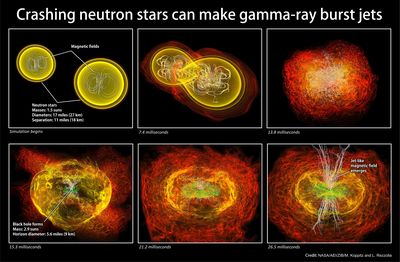
These images show the merger of two neutron stars recently simulated using a new supercomputer model. Redder colors indicate lower densities. Green and white ribbons and lines represent magnetic fields. The orbiting neutron stars rapidly lose energy by emitting gravitational waves and merge after about three orbits, or in less than 8 milliseconds. The merger amplifies and scrambles the merged magnetic field. A black hole forms and the magnetic field becomes more organized, eventually producing structures capable of supporting the jets that power short gamma-ray bursts. Credit: NASA/AEI/ZIB/M. Koppitz and L. Rezzolla
WASHINGTON -- A new supercomputer simulation shows the collision of two neutron stars can naturally produce the magnetic structures thought to power the high-speed particle jets associated with short gamma-ray bursts (GRBs). The study provides the most detailed glimpse of the forces driving some of the universe's most energetic explosions.
The state-of-the-art simulation ran for nearly seven weeks on the Damiana computer cluster at the Albert Einstein Institute (AEI) in Potsdam, Germany. It traces events that unfold over 35 milliseconds -- about three times faster than the blink of an eye.
GRBs are among the brightest events known, emitting as much energy in a few seconds as our entire galaxy does in a year. Most of this emission comes in the form of gamma rays, the highest-energy form of light.
"For the first time, we've managed to run the simulation well past the merger and the formation of the black hole," said Chryssa Kouveliotou, a co-author of the study at NASA's Marshall Space Flight Center in Huntsville, Ala. "This is by far the longest simulation of this process, and only on sufficiently long timescales does the magnetic field grow and reorganize itself from a chaotic structure into something resembling a jet."
See the website for more details.
http://www.nasa.gov/topics/universe/features/gamma-ray-engines.html(SY)
